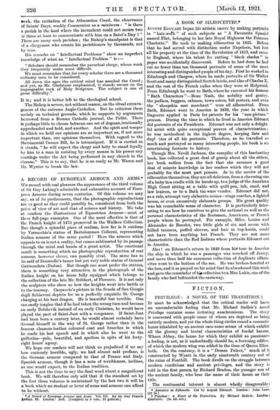A RECORD OF EUROPEAN ARMOUR AND ARMS.* WE record with
real pleasure the appearance of the third volume of Sir Guy Laking's admirable and exhaustive account of Euro- pean Armour during seven centuries. Of this volume we may say, as of its predecessors, that the photographic reproductions are as good as they could possibly be, considered from both the point of view of art and that of science and history. We take at random the illustrations of Equestrian Armour—most of them full-page examples. Ono of the most effective is that of the French knight of 1475 preserved in the Wallace Collection. But though a splendid piece of realism, how far is it outdone by Verrocchio's statue of Bartolommeo Colleoni, representing Italian armour of the same period ! Here the armour which appeals to us is not a reality, but comes sublimated by its passage through the mind and hands of a great artist. The emotional result is something which no photographic reproduction of real armour, however clever, can possibly rival. The same has to be said of Donatello's tamer but yet very noble statue of General Gattamelata (Padua). But though one must prefer the statues, there is something very attractive in the photograph of the Italian knight on his horse fully equipped which belongs to the collection of the late Mr. Stibbert, of Florence. It is not only the sculptors who show us how the knights went into battle or to the tourney. Carpaccio's picture in the Scuola of San Giorgio degli Sohiavoni depicts for us a perfectly exquisite St. George charging at his best dragon. He is beautiful but terrible. One can easily inagine that if he had taken the wrong turn and become an early Bolshevik instead of an early Christian, he would have played the part of Saint-Just with a vengeance. If Saint-Just had been born a century later, he would almost certainly have dressed himself in the way of St. George rather than in the famous chamois-leather coloured coat and breeches in which ho made his last speech and in which also he went to the guillotine—pale, beautiful, and spotless in spite of his forty- eight hours' agony.
We hope our readers will not think us prejudiced if we say how curiously horrible, ugly, we had almost said profane, is the German armour compared to that of France and Italy. Spanish armour, though it has a note of terribleness, inclines, as one would expect, to the Italian tradition.
This is not the time to say the final word about a magnificent book. We will therefore only add that if the standard set by the first three volumes is maintained by the last two it will be a book which no student or lover of arms and armour can afford to be without.
• A Record of European Armour and Arms. Vol. III. By Sir Guy Francis Salina. Bt. London : Bell. [Complete in 5 vols.. 16 guineas.]


































 Previous page
Previous page